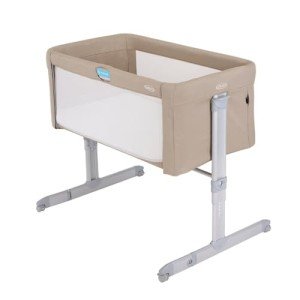14 Creative Ways To Spend On Leftover Bedside Cot For Infants Budget
The Importance of Bedside Cots for Infants: A Comprehensive Guide
As new parents start their parenting journey, they are confronted with a myriad of choices concerning their infant's sleep arrangements. Among these options, the bedside cot sticks out for its myriad of benefits. Bedside Crib For Attachment Parenting explores the significance of bedside cots, discusses their benefits and disadvantages, responses frequently asked questions, and consists of a relative table to assist parents make informed choices.
What Is a Bedside Cot?
A bedside cot is a sleep space developed to be placed next to the parents' bed, permitting easy access to the infant during the night. These cots include adjustable height settings, allowing them to align with the height of the adult bed. Often, they can be attached firmly to the bed or remain nearby, providing a safe yet accessible sleep environment for the baby.
Kinds Of Bedside Cots
- Co-Sleeping Cots: These cots connect securely to the parents' bed, enabling close distance while making sure the baby has their own safe sleeping space.
- Freestanding Cots: These are positioned beside the bed however do not connect straight. They still use a convenient grab feeding and reassuring.
- Portable Cots: These cots are light-weight and developed for travel, typically including foldable styles and easy-transport abilities.
Advantages of Using a Bedside Cot
Bedside cots offer several benefits that can enhance both the infant's sleep experience and the parents' peace of mind. These include:
1. Improved Safety
According to the American Academy of Pediatrics (AAP), having the infant sleep in the exact same room as parents, without sharing the same sleeping surface area, significantly lowers the threat of Sudden Infant Death Syndrome (SIDS). A bedside cot uses a safe space while maintaining proximity.
2. Easier Nighttime Care
When a baby is within arm's reach, feeding, diaper modifications, and reassuring ends up being far more convenient. Parents can rapidly soothe their infant without totally waking from sleep or leaving the bed.
3. Support of Bonding
The close proximity provided by a bedside cot motivates bonding throughout nighttime feedings or comforting. This can foster a complacency for the infant and aid develop stronger psychological connections.
4. Space-saving Design
Many bedside cots are developed to be compact, making them perfect for small home where a full-sized crib may not fit. They can be quickly moved or kept when not in use.
5. Versatile Functionality
A lot of bedside cots can be changed in height and typically feature removable sides, making them adaptable for various uses as the kid grows or family requires modification.
Downsides of Bedside Cots
Regardless of their benefits, there are some downsides to consider when choosing a bedside cot:
1. Limited Lifespan
Bedside cots generally have a shorter life expectancy than basic cribs, frequently accommodating infants only approximately a specific weight or height. Parents may need to transition to a complete crib quicker than expected.
2. Stability Concerns
If not safely connected or effectively placed, a bedside cot may pose safety concerns. Parents must make sure that the cot is steady and well-aligned with the bed.
3. Modification Period
Some infants may require time to get utilized to sleeping in a cot, particularly if they are used to closer contact. Parents may need to be patient as their child adapts.
How to Choose the Right Bedside Cot
When choosing a bedside cot, parents must think about the following requirements:
- Safety Standards: Ensure the cot adheres to all safety guidelines.
- Adjustability: Look for height-adjustable features that line up with your bed.
- Building and construction Material: Choose a cot that is tough and made from non-toxic products.
- Relieve of Use: Opt for designs that enable one-handed operation when accessing the infant.
Table: Comparison of Popular Bedside Cots
Feature
Co-Sleeping Cot
Freestanding Cot
Portable Cot
Attachment to Bed
Yes
No
No
Adjustability
Yes
Yes
Yes
Travel-Friendly
No
No
Yes
Lifespan
6-12 months
18-24 months
0-12 months
Cost Range
₤ 150-₤ 300
₤ 100-₤ 250
₤ 50-₤ 150
Often Asked Questions (FAQs)
1. Are bedside cots safe for my baby?
Yes, when used properly and according to security requirements, bedside cots are safe for infants. It is crucial to make sure that the cot is firmly located and does not pose any risk of falling.
2. At what age can I shift my baby from a bedside cot to a crib?
Many parents shift their baby from a bedside cot to a crib in between six months and 2 years, depending on the infant's development and comfort level.
3. Can I use a bedside cot for twins?
While some bedside cots are created to accommodate more than one kid, the majority of are meant for single infants. Parents of twins might require to consider using different cots.
4. How do I preserve my bedside cot?
Routine cleaning, looking for wear and tear, and making sure that all elements, such as security straps and bed mattress, remain in good condition, can assist keep your bedside cot.
Selecting the ideal sleep arrangement for an infant is among the many decisions that new parents deal with. A bedside cot uses unequaled benefit and safety while permitting close parental interaction. Understanding the advantages, downsides, and functions of bedside cots can empower parents to make the right option for their household's requirements. By weighing these factors along with security preventative measures, parents can create a nurturing sleep environment for their little ones.
